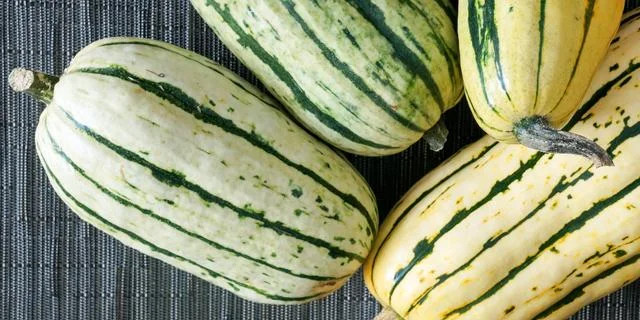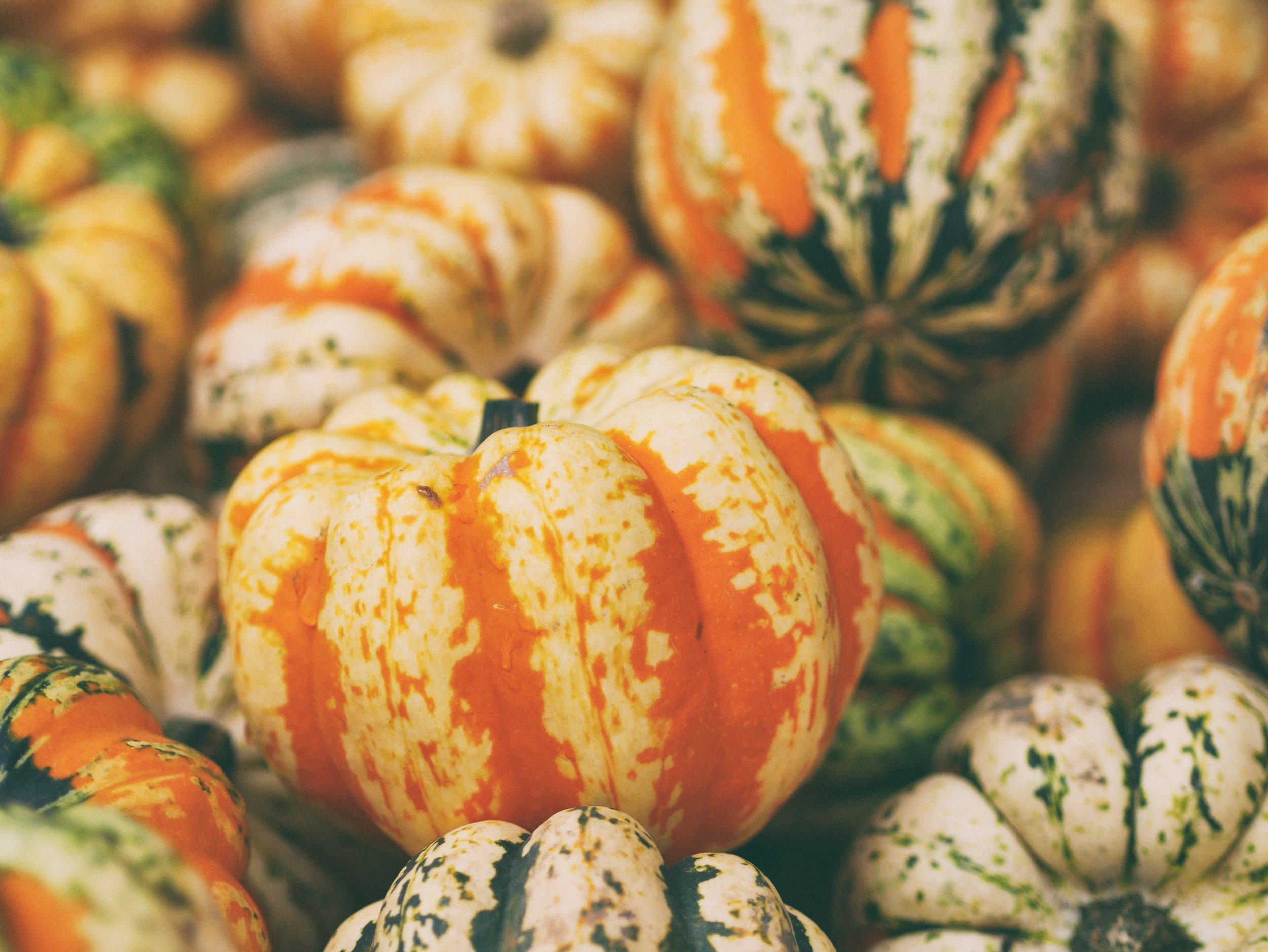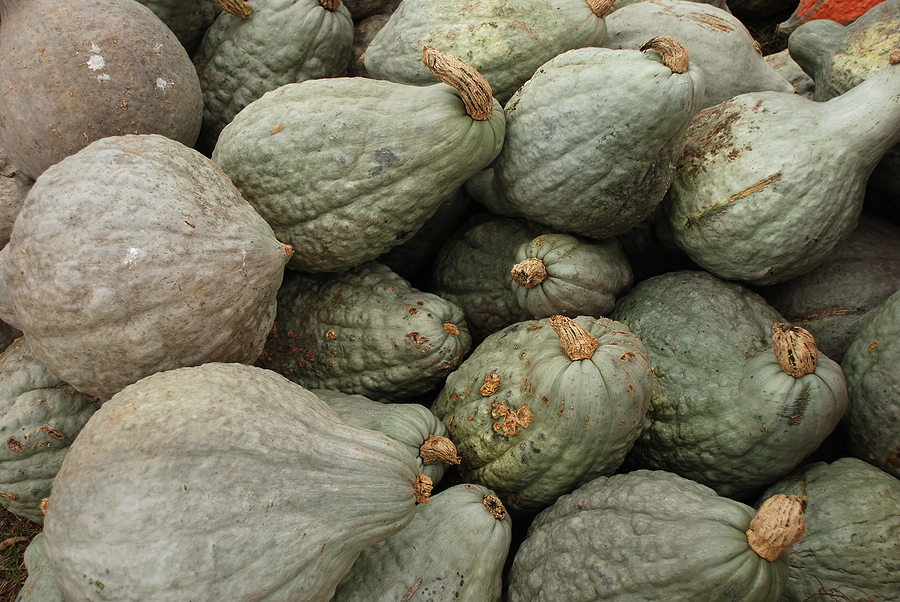With a dozen common varieties readily available, choosing a winter squash to prepare can be confounding for the home cook. We’ve compiled descriptions of common varieties as well as some handy tips for selecting the right squash for you and plenty of delicious squash recipes you'll love.
Delicata
Great "single-serving" squashes, perfect for halving and baking. You can serve them hot with butter and brown sugar, or stuff them with any number of fillings, from savory to sweet. Their flesh is yellow-orange, mild tasting, and quite juicy, and the rinds are tender enough to eat.
- Selection: Because they are more susceptible to breakdown than other winter squash, take care to select squash without scratches or blemishes, or they may spoil quickly.
- Best Uses: Delicata’s walls are thin, making it a quick-cooking squash. It can be sliced in 1/4-inch rings and sautéed until soft and caramelized (remove seeds first), halved and baked in 30 minutes, or broiled with olive oil or butter until caramelized.
- Other varieties: Sugar Loaf and Honey Boat are varieties of Delicata that have been crossed with Butternut. They are often extremely sweet with notes of caramel, hazelnut, and brown sugar.
Acorn
A little big for a single serving, these are classic, yellow-orange fleshed squashes. Creamy, nutty, and sweet, they're great for when you just want a cup or so of squash puree for a recipe. They are also a good size to slice or cube, without having more than you need.
- Selection: Acorn squash should be uniformly green and matte—streaks/spots of orange are fine, but too much orange indicates over ripeness and the squash will be dry and stringy.
- Best uses: baking, stuffing, mashing.
- Other varieties: all-white “Cream of the Crop,” and all-yellow “Golden Acorn.”
Heart of Gold/Festival/Carnival
These colorful, festive varieties of squash are all hybrids resulting from a cross between Sweet Dumpling and Acorn, and are somewhere between the two in size. Yellow or cream with green and orange mottling, these three can be difficult to tell apart, but for culinary purposes, they are essentially interchangeable. With a sweet nutty flavor like Dumpling, and a tender-firm texture like Acorn, they are the best of both parent varieties.
- Selection: Choose brightly colored squash that are heavy for their size.
- Best uses: baking, stuffing, broiling with brown sugar.
Butternut
The smooth textured, bright orange flesh of the butternut is perfect for cubing and roasting, or for pureeing for pies and cakes. Bonus points for having the long neck, which can be sliced crosswise to make beautiful rounds for roasting or layering in a gratin.
- Selection: Choose the amount of squash needed by weight. One pound of butternut equals approximately 2 cups of peeled, chopped squash.
- Best uses: soups, purees, pies, recipes where smooth texture and sweetness will be highlighted.
- Other varieties: “honey nut,” a sweeter and smaller version of butternut squash.
Spaghetti
These football-sized, bright yellow squash are very different from other varieties in this family. Spaghetti squash has a pale golden interior, and is stringy and dense. After sliced in half and baked, use a fork to pry up the strands of flesh and you will see it resembles and has the texture of perfectly cooked spaghetti noodles. These squash are not particularly sweet but have a mild flavor that takes to a wide variety of preparations.
- Selection: choose a bright yellow squash that is free of blemishes and soft spots.
- Best uses: baked and separated, then mixed with pesto, tomato sauce, or your favorite pasta topping.
Pie Pumpkins
Pie pumpkins differ from larger carving pumpkins in that they have been bred for sweetness and not for size. They are uniformly orange and round with an inedible rind, and are sold alongside other varieties of winter squash (unlike carving pumpkins which are usually displayed separately from winter squash). These squash are mildly sweet and have a rich pumpkin flavor that is perfect for pies and baked goods. They make a beautiful centerpiece when hollowed out and filled with pumpkin soup.
- Selection: Choose a pie pumpkin that has no hint of green and still has a stem attached; older pumpkins may lose their stems.
- Best uses: pies, custards, baked goods, curries and stews.
Hubbard
Good for feeding a crowd, these huge, bumpy textured squash look a bit like a giant gray lemon, tapered at both ends and round in the middle. A common heirloom variety, Blue Hubbard has an unusual, brittle blue-gray outer shell, a green rind, and bright orange flesh. Unlike many other winter squashes, they are only mildly sweet, but have a buttery, nutty flavor and a flaky, dry texture similar to a baked potato.
- Selection: Choose a squash based on size—1 pound equals approximately 2 cups of chopped squash (tip: if you don’t have use for the entire squash, some produce departments will chop these into smaller pieces for you).
- Best Uses: baked or mashed, topped with butter, sea salt, and freshly ground black pepper.
- Other varieties: Golden or Green Hubbard, Baby Blue Hubbard.
Kabocha (Green or Red)
Kabocha can be dark green with mottled blue-gray striping, or a deep red-orange color that resembles Red Kuri. You can tell the difference between red Kabocha and Red Kuri by their shape: Kabocha is round but flattened at stem end, instead of pointed. The flesh is smooth, dense, and intensely yellow. They are similar in sweetness and texture to a sweet potato.
- Selection: Choose heavy, blemish free squash. They may have a golden or creamy patch where they rested on the ground.
- Best Uses: curries, soups, stir-fry, salads.
- Other varieties: Buttercup, Turban, Turk’s Turban.
Red Kuri
These vivid orange, beta carotene-saturated squash are shaped like an onion, or teardrop. They have a delicious chestnut-like flavor, and are mildly sweet with a dense texture that holds shape when steamed or cubed, but smooth and velvety when pureed, making them quite versatile.
- Selection: Select a smooth, uniformly colored squash with no hint of green.
- Best Uses: Thai curries, soups, pilafs and gratins, baked goods.
- Other varieties: Hokkaido, Japanese Uchiki.
Sweet Dumpling
These small, four- to-six-inch round squash are cream-colored with green mottled streaks and deep ribs similar to Acorn. Pale gold on the inside, with a dry, starchy flesh similar to a potato, these squash are renowned for their rich, honey-sweet flavor.
- Selection: pick a smooth, blemish-free squash that is heavy for its size and is evenly colored. Avoid a squash that has a pale green tint as it is underripe.
- Best uses: baking with butter and cinnamon.
Reprinted by permission from StrongerTogether.coop. Find articles about your food and where it comes from, recipes and a whole lot more at www.strongertogether.coop










